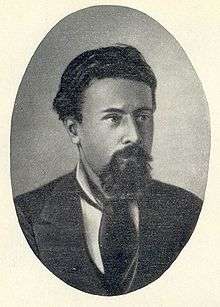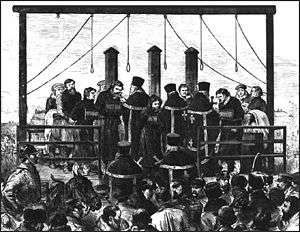Nikolai Kibalchich
Nikolai Ivanovich Kibalchich (Russian: Николай Иванович Кибальчич, Ukrainian: Микола Іванович Кибальчич,Serbian: Nикола Кибалчић, Mykola Ivanovych Kybalchych; 19 October 1853 – April 3, 1881) was a Russian revolutionary of Ukrainian-serbian origin who took part in the assassination of Tsar Alexander II as the main explosive expert for Narodnaya Volya (the People's Will), and was also a rocket pioneer. He was a distant cousin of revolutionary Victor Serge[1].
Nikolai Ivanovich Kibalchich | |
|---|---|
 | |
| Born | 19 October 1853 |
| Died | April 3, 1881 (aged 27) |
Early life
Born in Korop, Chernigov Governorate (present Ukraine) in 1853 into a clerical family,[2] Kibalchich was the son of an Orthodox parish priest.[3] He entered a gymnasium in 1864 but was later admitted to a seminary. But he returned to secondary school and finishing it with a silver medal several years later.[3]
In 1871 he entered St Petersburg Institute of Railway Engineers and in 1873 he entered Saint Petersburg Emperor Military Medical Academy to study medicine[4][2] and worked on experiments into pulsed rocket propulsion.[4]
Biography
In October 1875, Kibalchich was arrested for lending a prohibited book to a peasant. He spent 3 years in prison[3] before being sentenced to 2 months imprisonment.
He went on to join Narodnaya Volya in 1878,[3] becoming their main explosives expert.[3] In March 1881, he was charged with taking part in the assassination of Alexander II.
All through the night from February 28 to March 1, Mykolaj and his assistants - the Fleet Lieutenant Sukhnanov and Mikhail Grachvesky – worked without rest preparing the missile shells. The Peoples Will members had to be quick. Andrei Zhelyabov, who was to direct the missile throwers in an attempt on the life of the Emperor Alexander II, had been arrested on 27 February. If the Tsar survived the explosion, Zhelyabov was to kill him with a dagger. Zhelyabov’s arrest on the eve of the assassination attempt came as a complete surprise, although alarming rumors had appeared in February that the police were up to something. The plan was in jeopardy. There was no one to warn the Narodnaya-Volya people. Nikolai Kletochnikov, assistant to the file clerk of the Third (Security) Department, bearer of a Saint Stanislav Order, who had often warned the Narodniks about the gathering dangers, had been arrested at the end of January.
By the morning of March 1 four projectiles were ready. One of them killed Alexander II on March 1, 1881, on the embankment of the Yekaterininsky Canal in Saint Petersburg. Kibalchich was arrested on March 17.
"When his men came to see Kibalchich as his appointed counsel for the defense," said V.N Gerard in his statement to the special committee of the senate, "I was surprised above all by the fact that his mind was occupied with completely different things with no bearing on the present trial. He seems to be immersed in research on some aeronautic missile; he thirsted for a possibility to write down his mathematical calculations involved in the discovery. He wrote them down and submitted them to the authorities."

In a note written in his prison cell, Kibalchich proposed a manned jet air-navigating apparatus. He examined the design of powder rocket engine, controlling the flight by changing engines angle, the pro note is dated March 23. He produced this scientific work truly at death's door.
On March 26, General Komarov, Chief of the Gendarmery Department, informed the Police Department: "Pursuant to the request from Nikolai Kibalchich, the son of the priest, who is accused of high treason, I have the honor to present hereby his design of an aeronautic device."
The brief written in the report said: "To be filed with the March 1 dossier and to give this to scientists for consideration now would hardly be expedient since this can only give rise to a lot of wanton talk. Kibalchich’s design was put in an envelope, sealed and filed. The inventor was told that his design would be handed over to scientists for examination.
Kibalchich awaited for their answer. The month of March was at an end, with two days left before execution. On March 31 Kibalchich wrote this solicitation address to the Minister of Interior: “By instruction of your Excellency my design of an aeronautic apparatus has been submitted for the consideration of technical committee; could your Excellency direct that I be allowed to meet with any of the committee members on the matter of this design not later than tomorrow morning or at least to receive a written answer from the experts who have examined my design, also no longer than tomorrow.
I also ask your Excellency for permission for me, before I die, to meet with all my comrades in the trial or at least with Zhelyabov and Perovskaya." All the requests were ignored.
Execution and legacy
At 7:50 am on the sunny spring morning of April 3 two “chariots of shame” with the condemned prisoners rode out of the house of the detention to Shpalernaya Street. Zhelyabov was in the first, and by his side was Rysakov, who had tossed the first bomb at the coach of Alexander II and then betrayed his comrades during the interrogation. Kibalchich, Perovskaya and Mikhailov were in the second. The hands and feet of the condemned were tied to the seats. Each had on his chest a black plaque with the white colored inscription: “A regicide”.
At 9:21 am the executioner removed the foot stool from under the feet of Kibalchich. Mikhailov, Perovskaya, Zhelyabov and Rysakov were executed after him.
Thus, Kybalchych and other Narodnaya Volya plotters including Sophia Perovskaya, Andrei Zhelyabov, Nikolai Rysakov and Timofei Mikhailov were hanged on April 3, 1881.
The fate of the invention, mentioned in Kybalchych's last letter, proved to be as tragic as that of its 27-year-old creator. Kibalchich’s design was buried in the archives of Police Department, but the tsar authorities failed to consign the name of the inventor and his idea to oblivion. The trial and execution of the Narodniks had wide repercussions around the world. Much was said and written about Kibalchich’s design abroad and all kinds of conjectures were made about the essence of the invention and its subsequent fate. In 1917, Nikolai Rynin rediscovered the manuscript in the archives and published an account of it 1918 in the historic magazine Byloye (Былое, The Past).
In 1891, similar ideas were developed independently by the German engineer Hermann Ganswindt. After WWII, Stanislaw Ulam proposed a nuclear pulse propulsion scheme which was studied in Project ORION.
The International Astronomical Union honoured the rocketry pioneer by naming a crater on the moon Kibalchich's crater(Kibal'chich). Located at 3.0° N 146.5° W, the Moon's far side.
Final letter
The Dream of a propulsive device by a Scientist that was stolen by death
"I, Nikolai Kibalchich, am writing down this design in prison with several days to go before my execution. I believed in the practicability of my idea and this belief sustains me in my appalling situation by scientists and specialists who show my idea to be practicable, I will feel happy in the knowledge that I have rendered an immense service to my country and mankind. I will then calmly meet death, knowing that my idea will not die with me but will remain with mankind for which I prepared to sacrifice my life. That is why I pray to those scientists who will examine my design that they treat it with the utmost seriousness and good faith and let me know their answer as soon as possible.
First and foremost I need it necessary to note that, when at large, I did not have time to elaborate my design in details and prove its feasibility mathematically. Now it is, of course impossible for me to obtain the materials necessary for that. Consequently, this task that of substantiating my design with mathematical calculation will have to be done by those experts into whose hands my design will find its way.
Besides, I am not familiar with the mass of similar design which have, appeared lately; that is to say I am aware of the idea behind those designs but I am not familiar with the way whereby the inventors hope to carry them out. As far as I know, however my idea has not yet been proposed by anyone else.
In my thought about an aeronautic machine I have concentrated mainly on this question: what force has to be applied in order to set such machine in motion? In my opinion it is slowly burning explosive substances that can provide such a force.
In fact, the combustion of explosive substance results with a comparative rapidity in large quantity of gases possessing a huge energy at the instance of their formation. But can one use the energy of gases, formed by explosive ignition, to perform work of any duration? This is possible only if the huge energy of explosive combustion, rather than last instantaneously, will be generated during a more or less prolonged period of time."
References
- Serge, Victor (2002). Memoirs of a Revolutionary. University of Iowa Press. p. 2. ISBN 9780877458272. Retrieved 16 May 2020.
- Solymar, Laszslo (21 November 2013). Anatomy of Assassinations: from biblical times to the end of the second millennium. Author House. p. 115. ISBN 978-1-491-88182-8.
- "Nikolai Kibalchich - Science for Terrorism". Russia IC. 10 April 2008.
- "Кибальчич Николай Иванович". Famous scientists.
External links
| Wikimedia Commons has media related to Nikolai Kibalchich. |
- Croft, Lee B. Nikolai Ivanovich Kibalchich: Terrorist Rocket Pioneer. IIHS. 2006. ISBN 978-1-4116-2381-1.
- Encyclopedia of Astrobiology, Astronomy and Spaceflight
- Nikolai Rynin Interplanetary Flight and Communication Vol.2 No.4 pp36. Washington, D.C.: NASA and NSF, 1971
- Суд над цареубийцами. Дело 1-го марта 1881 года. Под редакцией В.В.Разбегаева. Изд. им. Н.И.Новикова. С-Пб том 1 и 2. 2014.ISBN 978-5-87991-110-7, ISBN 978-5-87991-112-1